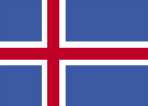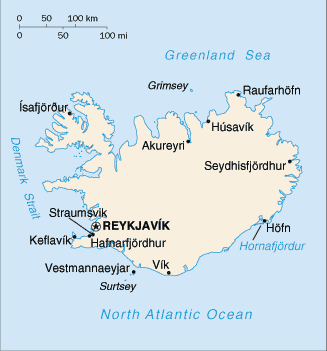|
Iceland
|

|
Capital: Reykjavik
Population: 339,031
Brief History of Iceland:
Iceland is an island country in the northern Atlantic Ocean. It is considered a part of Europe.
The Vikings arrived in Iceland in the 9th century. In 930 AD the local rulers established a parliament and a constitution. The parliament is the oldest in the world and is called the Althingi. In 1262, Iceland united with Norway. Later, the country joined with Norway and became a part of the Danish crown. When Norway later became independent again, Iceland remained united with Denmark.
In 1875 Iceland suffered a terrible natural disaster with the eruption of the Askja volcano. The country experienced widespread famine and the economy was devastated. Over the next twenty five years, 20% of the population left the island.
In 1918 Iceland became an independent state with some remaining ties to Denmark. Iceland would govern itself, but Denmark would handle foreign relations and defense. During WWI Iceland's defense was taken over by the United States. In 1944 Iceland became an independent republic and in 1946 the US no longer was responsible to defend Iceland. However, in 1951 the two countries once again came to a defense agreement. Iceland is the only NATO member with no military of its own.
The Geography of Iceland
Total Size: 103,000 square km
Size Comparison: slightly smaller than Kentucky
Geographical Coordinates: 65 00 N, 18 00 W
World Region or Continent: Arctic Region
General Terrain: mostly plateau interspersed with mountain peaks, icefields; coast deeply indented by bays and fiords
Geographical Low Point: Atlantic Ocean 0 m
Geographical High Point: Hvannadalshnukur 2,110 m (at Vatnajokull glacier)
Climate: temperate; moderated by North Atlantic Current; mild, windy winters; damp, cool summers
Major cities: REYKJAVIK (capital) 198,000 (2009)
The People of Iceland
Type of Government: constitutional republic
Languages Spoken: Icelandic, English, Nordic languages, German widely spoken
Independence: 1 December 1918 (became a sovereign state under the Danish Crown); 17 June 1944 (from Denmark)
National Holiday: Independence Day, 17 June (1944)
Nationality: Icelander(s)
Religions: Lutheran Church of Iceland 85.5%, Reykjavik Free Church 2.1%, Roman Catholic Church 2%, Hafnarfjorour Free Church 1.5%, other Christian 2.7%, other or unspecified 3.8%, unaffiliated 2.4% (2004)
National Symbol: gyrfalcon
National Anthem or Song: Lofsongur (Song of Praise)
Economy of Iceland
Major Industries: fish processing; aluminum smelting, ferrosilicon production; geothermal power, tourism
Agricultural Products: potatoes, green vegetables; mutton, dairy products; fish
Natural Resources: fish, hydropower, geothermal power, diatomite
Major Exports: fish and fish products 70%, aluminum, animal products, ferrosilicon, diatomite
Major Imports: machinery and equipment, petroleum products, foodstuffs, textiles
Currency: Icelandic krona (ISK)
National GDP: $12,410,000,000
** Source for population (2012 est.) and GDP (2011 est.) is CIA World Factbook.
Back to Geography Home Page
